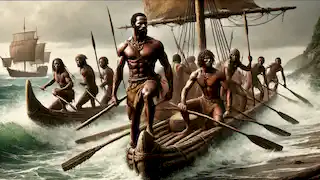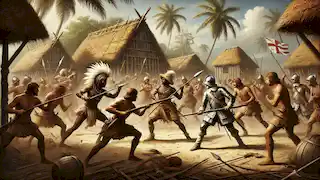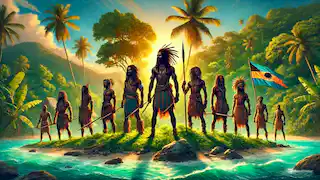The Caribbean is a region of warmth, beauty, and deep-rooted history. The story of the Carib people, a fierce and resilient tribe native to the islands, weaves a fascinating narrative of survival, culture, and conflict. Through their navigational prowess, spiritual beliefs, and warrior traditions, the Carib people have left an indelible mark on the Caribbean. Their encounters with neighboring tribes, European explorers, and the evolving world shaped their destiny, leaving behind a legacy both revered and misunderstood. This is their tale. Long before the first European ships arrived on the Caribbean’s turquoise shores, the islands were home to the indigenous Carib people. They were known as "Kalina" in their native tongue, a proud warrior society that thrived in the Lesser Antilles and along parts of South America’s northern coast. The Carib were seafaring people, masters of the waves, adept at navigating their canoes across great expanses of the sea. They were fearsome warriors, often engaging in conflicts with neighboring tribes, including the Arawak, who inhabited much of the Greater Antilles. The Carib’s ancestral roots are believed to trace back to the mainland of South America, specifically the regions that now form part of modern-day Venezuela, Guyana, and Suriname. Over centuries, they moved across the waters, settling on islands like Dominica, Saint Vincent, and Grenada. Their migrations brought them into frequent contact—and often conflict—with other indigenous peoples, establishing their reputation as a dominant force in the region. Yet, the Carib were more than just warriors. Their society was complex, with deep spiritual beliefs, traditions that honored their ancestors, and a way of life deeply intertwined with the natural world. They believed in the spirits of their ancestors, who they thought guided their lives from the afterworld. These spirits were appeased through rituals involving dance, music, and offerings of food. Carib men were hunters and warriors, while the women tended to agricultural duties, growing cassava, maize, and sweet potatoes. Their homes, called "ajoupas," were circular, thatched dwellings that protected them from the elements and symbolized their unity as a people. The Carib people’s relationship with the sea defined their existence. The Caribbean Sea provided them with food, trade routes, and a defense mechanism against invaders. Their canoes, built from hollowed-out tree trunks, were marvels of craftsmanship, sturdy enough to withstand long voyages and light enough to navigate swift river currents. These maritime skills were key to their dominance over the neighboring Arawak people. The Carib frequently raided Arawak settlements in search of resources, captives, and land. It was said that the Carib practiced a form of ritualistic cannibalism, consuming the flesh of their enemies in a show of dominance and spiritual belief that they absorbed the strength of their foes. Whether exaggerated or not, these stories spread fear among their enemies and cemented their status as a fearsome warrior race. However, Carib society wasn’t solely defined by warfare. The sea also connected them to distant tribes, facilitating trade in goods like pottery, food, and woven baskets. These exchanges introduced new techniques and materials that enriched Carib culture. Fish, sea turtles, and shellfish formed a significant part of their diet, supplemented by crops grown in the fertile soils of the islands. The Carib respected the ocean, believing that spirits inhabited its depths. They would offer prayers before long voyages, seeking safe passage from the gods. The Carib’s world changed forever in 1493 when Christopher Columbus sailed through the Lesser Antilles on his second voyage. Though he initially made contact with the Arawak people, his reports of the Carib as savage, warlike people soon filtered back to Europe. The Spanish, Portuguese, and later the French and British began to take an interest in the Caribbean islands, seeing them as valuable stepping stones for their imperial ambitions. The Europeans, with their guns, steel, and horses, brought technologies the Carib had never encountered. Despite these advantages, the Carib fiercely resisted European encroachment on their lands. The Carib had a long tradition of warfare, and their knowledge of the terrain, combined with their guerrilla tactics, made them formidable opponents. However, European diseases like smallpox, measles, and influenza spread through the indigenous populations with devastating speed. Lacking immunity to these new diseases, entire Carib villages were wiped out. By the early 16th century, European settlements had begun to take root in the Caribbean, leading to a series of violent confrontations. In particular, the French and English settlers who established colonies on islands like Saint Kitts, Nevis, and Barbados found themselves in direct conflict with the Carib. Many battles ensued, with the Carib employing ambushes and surprise attacks to slow the Europeans' expansion. As the 17th century progressed, the Carib people found themselves increasingly surrounded by European settlers. While some tribes were forced into submission or wiped out by disease, others refused to surrender. On islands like Dominica and Saint Vincent, the Carib mounted fierce resistance against colonization. They would not easily give up the lands that had sustained their people for generations. The Garifuna people, descendants of the Carib and African slaves who had escaped from European captivity, became key players in the resistance. On Saint Vincent, these "Black Caribs" were particularly strong, blending Carib fighting techniques with African resilience. They successfully held off French and British attempts to fully colonize the island for many years. Despite their efforts, the Carib were gradually pushed to the margins. Treaties were signed with European powers, often under duress, and the once-proud Carib found their lands shrinking as sugar plantations spread across the Caribbean. Still, the Carib refused to disappear completely. On islands like Dominica, their descendants remain to this day, preserving what remains of their ancestral culture and heritage. {{{_04}}} Though the Carib people were largely decimated by the forces of colonization, their legacy endures in the Caribbean. The Garifuna, descendants of Carib and African people, continue to live along the coasts of Central America, maintaining the traditions of their ancestors. In the 21st century, the indigenous Carib population, now referred to as the Kalinago, still exists on the island of Dominica, where they preserve their unique cultural practices. The Carib’s contributions to the Caribbean go beyond their martial prowess. Their navigational skills, agricultural practices, and knowledge of the natural world laid the foundations for many of the region’s indigenous cultures. Their relationship with the land and sea shaped the very identity of the Caribbean, leaving a lasting imprint on its culture and history. The Carib people were resilient, adapting to the changing world around them even in the face of overwhelming odds. They fought valiantly to protect their way of life, and though much of their world was lost to colonization, their story survives in the hearts of their descendants. Today, festivals, ceremonies, and public spaces honor the memory of the Carib people. Across the islands, their name is synonymous with strength, survival, and the enduring spirit of the Caribbean.The Roots of the Carib People

Masters of the Sea

The Arrival of the Europeans

The Carib Resistance
Legacy and Survival
The Tale of the Carib People
Reading Time: 6 min

About Story: The Tale of the Carib People is a Historical Fiction Stories from dominica set in the Renaissance Stories. This Descriptive Stories tale explores themes of Courage Stories and is suitable for Adults Stories. It offers Historical Stories insights. The rise, resistance, and enduring legacy of the Carib people in the Caribbean.

















